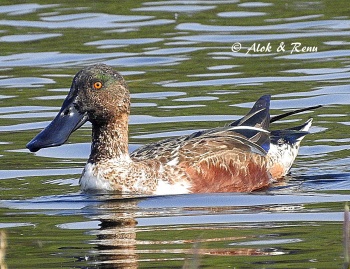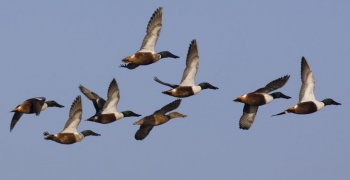(→External Links: New Video search created) |
|||
| (31 intermediate revisions by 11 users not shown) | |||
| Line 1: | Line 1: | ||
| − | + | [[Image:Northern_Shoveler.jpg|thumb|550px|right|Male (left) and female<br />Photo © by {{user|Steve+G|Steve G}}<br />The Flood, [[Vane Farm]], Loch Leven, [[Scotland]], [[UK]], 03 April 2005]] | |
| − | [[Image:Northern_Shoveler.jpg|thumb|550px|right|Photo by Steve G<br/> | + | ;[[:Category:Spatula|Spatula]] clypeata |
==Identification== | ==Identification== | ||
| − | + | [[Image:northern_shoveler_eclipse.JPG|thumb|350px|right|Male moulting<br />Photo © by {{user|aloktewari|Alok Tewari}}<br />[[Bharatpur Keoladeo National Park|Keoladeo National Park]], [[India]], 17 December 2015]] | |
| + | Length 43–56 cm (17-22 in), wingspan 70–85 cm, weight 400–1100 g<br /> | ||
| + | '''Male''' | ||
| + | *Bottle green head | ||
| + | *Chestnut flanks | ||
| + | *White breast | ||
| + | *Very large black spatula shaped bill | ||
| + | *In flight, pale blue forewing feathers are revealed, separated from the green speculum by a white border | ||
| + | *Eclipse plumage (July to October) very similar to female (including in bill colour), but flanks more orangey and blue forewing retained | ||
| + | *Post-eclipse (September to December) often develops a weak whitish forehead crescent resembling [[Australian Shoveler]] or even [[Blue-winged Teal]] in moult<br /> | ||
| − | + | '''Female''' | |
| + | *Light brown | ||
| + | *Grey forewing | ||
| + | *Very large grey and orange spatula shaped bill | ||
| − | + | ====Similar Species==== | |
| + | [[Image:Shoveler 177K3996.jpg|thumb|350px|right|Flock in flight <br />Photo © by {{user|targetman|targetman}}<br />[[Lincolnshire]] 02 March 2009]] | ||
| + | Females, and males moulting out of eclipse, are very similar to females and full-plumage males respectively of [[Australian Shoveler]]; the two species do not normally overlap in distribution, but vagrant Northern are known in the range of Australian, and need great care in identification. The plumage of the female is also similar to that of a female [[Mallard]], the bill being the major distinguishing feature. | ||
| − | + | ==Distribution== | |
| + | Breeds across northern areas of [[Europe]], [[Asia]] and most of [[North America]] between roughly 40° to 65°N latitude. It is largely migratory, wintering across more southern regions of these continents, and also in [[South America]] and [[Africa]] south to around 5° to 10°N latitude; small numbers winter as far north as [[Scotland]] and [[British Columbia]] where mild oceanic winters allow some overlap with the breeding range. | ||
| + | |||
| + | It is a vagrant south to central [[South America]], [[Australia]], and [[South Africa]], and north to [[Svalbard]]; it has also been recorded on the [[Azores]], [[Madeira]], the [[Canary Islands]], and several Pacific Ocean islands. | ||
| − | + | ==Taxonomy== | |
| + | This is a [[Dictionary_M-S#M|monotypic]] species<sup>[[#References|[1]]]</sup>. | ||
| − | + | The Northern Shoveler has recently been transferred, along with several other related, mostly large-billed ducks, to the genus ''[[:Category:Spatula|Spatula]]''. These were all formerly placed in the genus ''[[:Category:Anas|Anas]]''. | |
| − | The Northern Shoveler | ||
| − | |||
| − | |||
| − | |||
==Habitat== | ==Habitat== | ||
| − | + | Marshlands and overgrown ponds. Rarely on the sea. Breeds in shallow, lowland, freshwater wetlands. | |
==Behaviour== | ==Behaviour== | ||
| − | It | + | It is not as gregarious as some other dabbling ducks in the breeding season, usually only forming small parties, but huge flocks can occur in winter on suitable subtropical and tropical wetlands (e.g. 110,000 in the Marismas Nacionales in [[Nayarit]], western [[Mexico]]<sup>[[#References|[2]]]</sup>). |
| − | + | Complex courtship display, when groups of males will head-bob to females, and perform frequent noisy aerial chases after females. | |
| + | ====Diet==== | ||
| + | Dabbling duck, uses bill to filter food. Will eat tiny crustaceans, insects as well as seed and plant matter. | ||
| + | ====Breeding==== | ||
| + | The nest is a shallow depression on the ground, lined with plant material and down, usually close to water. | ||
| + | ====Vocalisation==== | ||
| + | Fairly quiet except during courtship. Females a mallard-like ''quack''. Males have an odd-sounding "shukk, shukk, shukk, shukk" when displaying and in aerial chases. | ||
| − | + | {{ Audio|Anas clypeata (song).mp3 }} | |
| + | ==References== | ||
| + | #{{Ref-Clements6thAug18}}#{{Ref-HBWVol1}}#Carboneras, C. & Kirwan, G.M. (2019). Northern Shoveler (Spatula clypeata). In: del Hoyo, J., Elliott, A., Sargatal, J., Christie, D.A. & de Juana, E. (eds.). Handbook of the Birds of the World Alive. Lynx Edicions, Barcelona. (retrieved from https://www.hbw.com/node/52896 on 22 May 2019). | ||
| + | #{{Ref-Collins5th93}}#Dubowy, P. J. (1996). Northern Shoveler (Spatula clypeata), version 2.0. In The Birds of North America (A. F. Poole and F. B. Gill, Editors). Cornell Lab of Ornithology, Ithaca, NY, USA. https://doi.org/10.2173/bna.217 | ||
| + | {{ref}} | ||
| + | ==External Links== | ||
| + | {{GSearch|"Spatula clypeata" {{!}} "Anas clypeata" {{!}} "Northern Shoveler"}} | ||
| + | <br /> | ||
| + | {{VSearch|"Spatula clypeata" {{!}} "Anas clypeata" {{!}} "Northern Shoveler"}} | ||
| + | {{GS-checked}}1 | ||
| + | <br /> | ||
| + | <br /> | ||
| − | + | [[Category:Birds]][[Category:Spatula]][[Category:Bird Songs]] [[Category:Videos]] | |
| − | |||
| − | |||
| − | |||
| − | |||
| − | |||
| − | [[Category: | ||
Latest revision as of 23:12, 10 February 2023
- Spatula clypeata
Identification
Length 43–56 cm (17-22 in), wingspan 70–85 cm, weight 400–1100 g
Male
- Bottle green head
- Chestnut flanks
- White breast
- Very large black spatula shaped bill
- In flight, pale blue forewing feathers are revealed, separated from the green speculum by a white border
- Eclipse plumage (July to October) very similar to female (including in bill colour), but flanks more orangey and blue forewing retained
- Post-eclipse (September to December) often develops a weak whitish forehead crescent resembling Australian Shoveler or even Blue-winged Teal in moult
Female
- Light brown
- Grey forewing
- Very large grey and orange spatula shaped bill
Similar Species
Females, and males moulting out of eclipse, are very similar to females and full-plumage males respectively of Australian Shoveler; the two species do not normally overlap in distribution, but vagrant Northern are known in the range of Australian, and need great care in identification. The plumage of the female is also similar to that of a female Mallard, the bill being the major distinguishing feature.
Distribution
Breeds across northern areas of Europe, Asia and most of North America between roughly 40° to 65°N latitude. It is largely migratory, wintering across more southern regions of these continents, and also in South America and Africa south to around 5° to 10°N latitude; small numbers winter as far north as Scotland and British Columbia where mild oceanic winters allow some overlap with the breeding range.
It is a vagrant south to central South America, Australia, and South Africa, and north to Svalbard; it has also been recorded on the Azores, Madeira, the Canary Islands, and several Pacific Ocean islands.
Taxonomy
This is a monotypic species[1].
The Northern Shoveler has recently been transferred, along with several other related, mostly large-billed ducks, to the genus Spatula. These were all formerly placed in the genus Anas.
Habitat
Marshlands and overgrown ponds. Rarely on the sea. Breeds in shallow, lowland, freshwater wetlands.
Behaviour
It is not as gregarious as some other dabbling ducks in the breeding season, usually only forming small parties, but huge flocks can occur in winter on suitable subtropical and tropical wetlands (e.g. 110,000 in the Marismas Nacionales in Nayarit, western Mexico[2]).
Complex courtship display, when groups of males will head-bob to females, and perform frequent noisy aerial chases after females.
Diet
Dabbling duck, uses bill to filter food. Will eat tiny crustaceans, insects as well as seed and plant matter.
Breeding
The nest is a shallow depression on the ground, lined with plant material and down, usually close to water.
Vocalisation
Fairly quiet except during courtship. Females a mallard-like quack. Males have an odd-sounding "shukk, shukk, shukk, shukk" when displaying and in aerial chases.
References
- Clements, J. F., T. S. Schulenberg, M. J. Iliff, D. Roberson, T. A. Fredericks, B. L. Sullivan, and C. L. Wood. 2018. The eBird/Clements checklist of birds of the world: v2018. Downloaded from http://www.birds.cornell.edu/clementschecklist/download/
- Del Hoyo, J, A Elliot, and J Sargatal, eds. 1992. Handbook of the Birds of the World. Volume 1: Ostrich to Ducks. Barcelona: Lynx Edicions. ISBN 978-8487334108
- Carboneras, C. & Kirwan, G.M. (2019). Northern Shoveler (Spatula clypeata). In: del Hoyo, J., Elliott, A., Sargatal, J., Christie, D.A. & de Juana, E. (eds.). Handbook of the Birds of the World Alive. Lynx Edicions, Barcelona. (retrieved from https://www.hbw.com/node/52896 on 22 May 2019).
- Peterson, RT, G Mountfort and PAD Hollom. 1993. Collins Field Guide – Birds of Britain and Europe, 5th Revised edition. London: HarperCollins Publishers. ISBN 978-0002199001
- Dubowy, P. J. (1996). Northern Shoveler (Spatula clypeata), version 2.0. In The Birds of North America (A. F. Poole and F. B. Gill, Editors). Cornell Lab of Ornithology, Ithaca, NY, USA. https://doi.org/10.2173/bna.217
Recommended Citation
- BirdForum Opus contributors. (2024) Northern Shoveler. In: BirdForum, the forum for wild birds and birding. Retrieved 7 May 2024 from https://www.birdforum.net/opus/Northern_Shoveler
External Links
GSearch checked for 2020 platform.1






